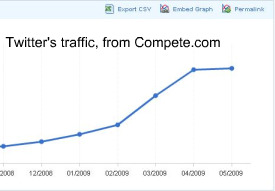Twitter Reaches a Crossroads

Twitter is easily one of the most hyped platforms on the Web over the past year. And rightly so; it's astronomical growth rate is a rarity. But according to new data from Compete.com, Twitter's growth has hit a major wall. From April to May, Twitter's unique visitors grew just 1.4 percent - a far cry from when traffic more than doubled from February to April. Does this mean that Twitter mania is over?
There is little doubt that Twitter has gained some form of acceptance with the public. But major doubt exists over who that public is, exactly. A recent study by Harvard Business Review revealed that just 10 percent of Twitter users account for a whopping 90 percent of messages sent, or tweets. According to the study, "This implies that Twitter resembles more of a one-way, one-to-many publishing service more than a two-way, peer-to-peer communication network." On a typical social network, the top 10 percent of users account for 30 percent of production.
 In addition, the study shows that half of Twitter users tweet less than once every 74 days, and the median number of lifetime tweets is exactly ... one. That paints a picture of a handful of rabid users, and a gross majority of users who signed up out of curiosity, then abandoned the idea. Or, these hyper-active Twitter users have several, even dozens of different accounts - a very likely scenario. Similar to domain squatting, some Twitter users have snapped up usernames in the hopes of earning some kind of return down the line. That's evidenced by Twitter's announcement of Verified Accounts, coming soon.
In addition, the study shows that half of Twitter users tweet less than once every 74 days, and the median number of lifetime tweets is exactly ... one. That paints a picture of a handful of rabid users, and a gross majority of users who signed up out of curiosity, then abandoned the idea. Or, these hyper-active Twitter users have several, even dozens of different accounts - a very likely scenario. Similar to domain squatting, some Twitter users have snapped up usernames in the hopes of earning some kind of return down the line. That's evidenced by Twitter's announcement of Verified Accounts, coming soon.
When you put it all together, it appears Twitter is being used by a few very heavily, and mostly to broadcast information in the hopes of generating attention and traffic. And, based on Twitter's current iteration and news about Twitter search to include content included in all those tiny links, that's exactly what Twitter is - an information portal and distribution service.
So does this decrease Twitter's value?
Not necessarily. While the sudden traffic stall is slightly alarming, it was bound to happen at some point. And even if Twitter users are not tweeting themselves, they are listening in. Just like Wikipedia is edited by a very small percentage of Wikipedia users, the site is visited by millions of people to gather information. While you may not be communicating with as many people as initially thought, this is no reason to abandon your Twiitter marketing efforts. Just understand that the numbers are highly inflated. That said, any time major media sources, pro sports teams, celebrities and professional organizations are promoting their Twitter feeds to the public, so should you.
The real threat to Twitter are forged followers and relationships. Twitter users look to an account's followers as an indication of their value. And followers can be easily inflated. Just like link farms of the past, there are "follower farms." Pay a few bucks, get thousands of followers. It's also thought that retweets will indicate authority on a given topic or Twitter account. Again, easily forged by using multiple accounts. As Twitter evolves into an information portal, there's a rush to index all of that content (and there is tons of it). Where Google has PageRank and link authority, Twitter has followers and retweets.
If they're not careful, Twitter runs the risk of incurring the same problems as every other search engine. It is of critical importance that Twitter find a way to quantify followers and relationships. From a user perspective, the value of Twitter is in the connections - we follow those with whom we share interests so that we receive relevant information and cut down on all the noise. If this system is too easily manipulated, it's a huge step backwards in semantic search, an area where Twitter has massive potential.

Subscribe to Our Newsletter!
Latest in Social Media










